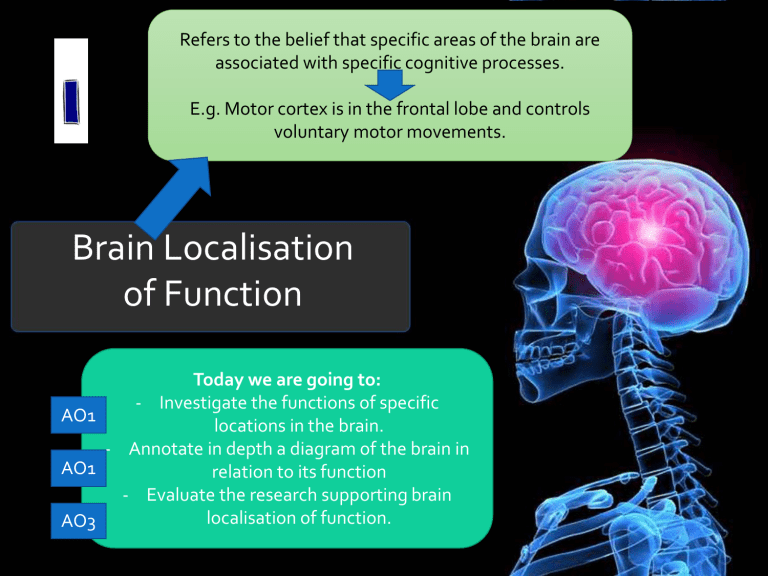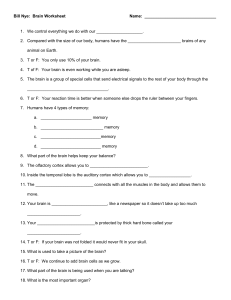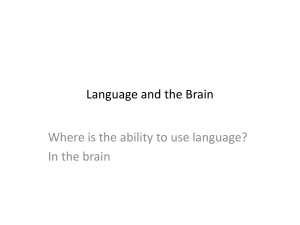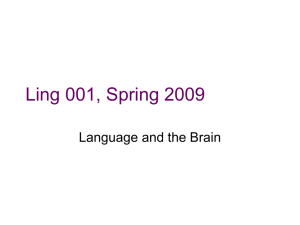
Refers to the belief that specific areas of the brain are associated with specific cognitive processes. E.g. Motor cortex is in the frontal lobe and controls voluntary motor movements. Brain Localisation of Function Today we are going to: - Investigate the functions of specific AO1 locations in the brain. - Annotate in depth a diagram of the brain in AO1 relation to its function - Evaluate the research supporting brain localisation of function. AO3 So what is localisation of function? Specific functions (physical and Psychological) of the brain have specific locations in the brain Before 19th Century when Broca’s and Wernicke’s areas were discovered Psychologists widely adopted a holistic theory of the brain – all parts of the brain were thought to be involved in processing of thought and action. It is now widely assumed that if brain damage occurs to a specific area of the brain, the associated function would also be damaged. • https://www.youtube.com/watch?v=mD34o -sW22A – using TMS to locate function Franz Gall’s theory of phrenology (looking at the structure of the skull to determine a persons character) was influential but quickly discredited Hemispheres and the cerebral cortex - Brain is divided into two symmetrical halves called left and right hemispheres - Some functions are dominated by one hemisphere (lateralisation) - Activity on left side of body is controlled by right hemisphere and vice versa. - The outer layer of both hemispheres is called the cerebral cortex, a 3mm layer covering the inner parts of the brain. - This separates us from other animals as the cortex is developed. It appears grey – grey matter. Your Task Today Motor Cortex • Responsible for generation of voluntary motor movements • Located in frontal lobe along the bumpy region (!) the precentral gyrus • On both hemispheres – motor cortex on right hemisphere controlling muscles on left side of body and vice versa • Different parts of the motor cortex control different parts of the body • These are arranged logically – the region that controls the foot is next to the region that controls the leg Somatosensory Cortex • Detects sensory events from different regions of the body • In parietal lobe along a region called the postcentral gyrus • Dedicated to the processing of sensory info related to touch • Uses sensory info from skin to produce sensations such as touch pressure, pain, temperature which it then localises to specific body regions • Both hemispheres have a somatosensory cortex • The cortex on one side of the brain receives sensory info from the opposite side of the body Visual Centres • Located in the visual cortex in the occipital lobe • Visual processing begins in retina (light enters and strikes the photoreceptors (rods and cones)) • Nerve impulses from the retina travel to areas of the brain via the optic nerve • Most terminate in the thalamus, this acts as a relay station passing info to visual cortex • Visual cortex spans both hemispheres • The right hemisphere receiving its input from the left-hand side of the visual field and vice versa • Visual cortex contains different areas that process different types of visual info such as colour, shape and movement Auditory Centres • Concerned with hearing • In temporal lobes on both sides of brain where the auditory cortex is • Begins in cochlea in inner ear, sound waves are converted to nerve impulses • These travel via the auditory nerve to the auditory cortex • Pit stop at the brain stem where basic decoding happens e.g. the duration and intensity of sound • Then on to thalamus which acts as a relay station and carries out further processing of auditory stimulus • Last stop is at the auditory cortex • Sound has already been largely decoded by this point, in the auditory cortex it is recognised and may result in an appropriate response Broca’s Area • • • • • • • • Named after Paul Broca, French neurosurgeon Treated a patient called ‘Tan’ – unable to speak other than this one word (but did understand language) Studied 8 other patients who similar language deficits, along with lesions in their left frontal hemisphere Patients with damage to their right frontal hemisphere did not have the same problems This lead him to identify the existence of a language centre in the back portion of the frontal lobe of the left hemisphere (Broca 1865) Believed to be critical for speech production HOWEVER neuroscientist have found that when people perform cognitive tasks (nothing to do with language) their Broca area is active Fedorenko (2012) discovered 2 regions of Broca’s area – one selectively involved in language, the other involved in responding to many demanding cognitive tasks (such as performing maths problems) Wernike’s Area • • • • • • • • • • • German neurologist called Carl Wernicke Discovered another area of the brain that was involved in understanding language Back portion of left temporal lobe Patients with lesions on their Wernicke’s area could speak but were unable to understand language Proposed that language involved separate motor and sensory regions located in different cortical regions The motor region, located in Broca’s area, is close to the area that controls the mouth, tongue and vocal cords. The sensory region, located in Wernicke's area, is close to the regions of the brain responsible for auditory and visual input Input from these regions transferred to Wernicke’s area when recognised as language and associated meaning There is a neural loop (arcuate fasciculus) running between Broca’s area and Wernicke’s area At one end lies Broca’s area – responsible for the production of language At the other lies Wernicke’ area – responsible for the processing of spoken language Which part does which? Walking to the bus stop. Listening to your favourite song. Understanding the meaning of Harry Potter. Speaking to your Granny on the phone. Judging whether you need to wear a coat or not. Apply it! The case of Phineas Gage • https://www.youtube.com/watch?v=flRamGB SoP4 • Does the case of Gage support the localisation of function theory or holistic theory? • Why is it difficult to draw general conclusions from this case? Weakness: Equipotentiality • Lashley (1930) • Not all researchers agree that cognitive functions are localised in the brain. Equipotentiality theory explains that whilst basic motor and sensory functions are localised, higher mental functions were not. • Lashley claimed that intact areas of the cortex could take over responsibility for specific cognitive functions, following injury to the area normally responsible for that function. • Therefore the effects of brain damage would be determined by the extent rather than the location of damage. Weakness: Communication • Communication between different parts of the brain may be more important than the specific regions which control a particular cognitive process in the brain. • Wernicke claimed that the regions of the brain are interdependent – they have to work together. • Dejerine (1892) – described a case in which the loss of an ability read resulted from the damage of the connection between the visual cortex and Wernike’s area. • This suggests that for complex behaviours such as language, the response is produced through movement through different structures in the brain, showing the importance of the connection between two points. • It is the damage to the connection between two points which has the impact on the function of the brain. Strength: Language Centres • Aphasia – an inability or impaired ability to understand or produce speech as a result of brain damage. • It has been found that Expressive aphasia (Broca’s Aphasia) is an impaired ability to produce language – caused by damage to the Broca’s area. This demonstrates the role played by this brain region in the production of language. • It has been found that Receptive aphasia (Wernicke’s Aphasia) is an impaired ability to understand language – caused by damage to the Wernicke’s area. This demonstrates the role played by this brain region in the understanding/comprehension of language. Weakness: Individual Differences • There are individual differences in brain localisation. • Bavelier et al found a large variability in individual patters of activation across different individuals. They observed differences in activity across the right temporal love, left frontal, temporal and occipital lobes. • Harasty et al found that women have proportionally larger Broca’s and Wernicke’s area than men, the result of women’s greater use of language. Weakness: Language Production • Dronkers et al • MRI scans have revealed that other areas besides Broca’s area could also have contributed to the patients’ reduced speech abilities. • This suggests that lesions to Broca’s aea alone can use temporary speech disruption, they do not usually result in severe disruption of spoken language, suggesting that language and cognition are far more complicated than once thought and involve networks of brain regions, not just localisation to specific areas.







